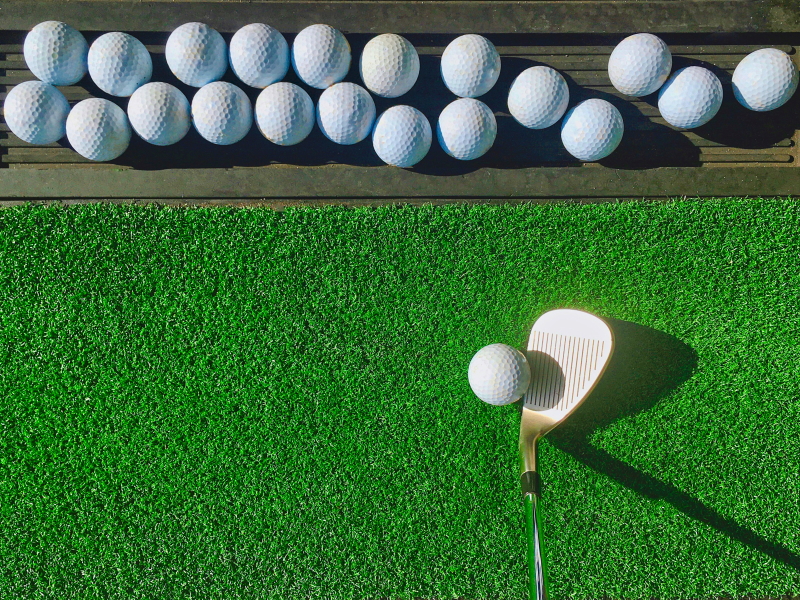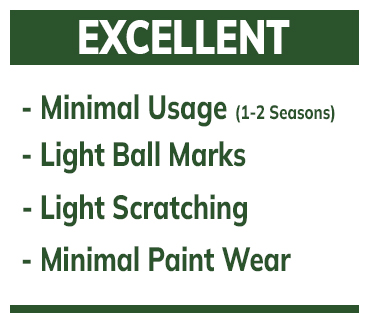

Table Of Contents: Golf Club Buyer's Guide
What Golf Clubs Should You Buy?
When purchasing golf clubs, consider your skill level, playing style, and budget. New players and those with mid-to-high handicaps should buy clubs appropriate for their level. Beginners can start with a complete golf set that includes a driver, 3-wood, irons, and a putter. It's advisable to try various brands and setups before buying and think about custom fitting once you understand your game and style better. Consulting a professional fitter can assist in selecting clubs tailored to your specific needs and preferences. The ideal golf clubs for you will ultimately reflect your unique playing traits and your dedication to the sport.
The Golf Club Guide
This golf club buyers guide is designed to be a foundational resource for all golfers. It helps break down the different components of a typical golf club and how those components work. We also go over the different types of club families and how you use them for different situations on the course. This information is beneficial in understanding your golf equipment for the beginner and the pro golfer alike.
The Basics
While every golf club type has characteristics specially designed for that category, there are basics to consider that apply to all clubs. And these parts are consistent across all club types. Yes, a club's components, appearance, and specialized function can vary from club type to club type. However, you will notice certain parts of a club are universal. Here is a list of all the standard club components.
The Grip
Some may overlook the benefits of a good golf grip, but that could be a mistake. Every stroke you take starts with positioning your hands on the top of the club. Control, responsiveness, and firmness all come into play here. Naturally, personal preference also comes into play here, and grips come with options. The thickness of the grip can vary depending on what works best for the golfer. While they come in different sizes, some players opt to use tape to thicken the grip to the desired width.
Another feature of grips is the design or texture of the grip. Some grips are smooth. Others offer grooves. Grooved grips are another way to get more friction as you hold and swing the club. For some, this may be a critical difference. Beyond just the grip's texture and width, you may also hear some golfers talk about the feel. The feel is a reference to the firmness of the grip. Some golfers prefer a firm grip. It can help them sense things in the club more effectively, allowing them use this feedback to make more accurate shots.

The Shaft
You will often hear two areas mentioned with a shaft: weight and flex. Weight, of course, is mainly determined by the material of the shaft. In today's modern golf game, club speed is critical to generate power on a swing. A lighter, faster club allows you to swing with greater velocity. Thus, modern clubs are built with alloys that allow strength with less weight than traditional materials like wood and steel. The result is more powerful swings.
Beyond just weight, modern club shafts have different levels of flex. Flex is the ability of the club to bend. And a more flexible shaft can be significant for players with less upper body strength who will benefit from this type of shaft. Inversely more advanced players or players with a stronger swing will opt for a stiffer shaft.
Another critical function of the staff is, of course, leverage. You will notice drivers are longer to help transfer more energy from you into the ball. As you get closer to the green, you need less distance and more precision. Subsequently, the shafts get shorter from drivers to irons to putters.
The Club Head
The club head is the most recognizable part of the club, and it is attached to the bottom (or tip) of the shaft. Beyond shaft length, a lot of the differentiation between the different families of clubs is found in the club head. Naturally, the club head is the part of the club that impacts the ball. At first glance, you might think the function of a club head is just a hitting surface. While this describes the process of what it does, it is much more complicated than that.
Different types of clubs have distinctive club heads and club faces. These correspond to the function of the different kinds of clubs. For example, the driver, or the 1-wood, has a large, bulbous head. This type of club head is designed to give you a large hitting surface and lots of power at the moment of impact. Irons have a club head designed to lift and grip the ball, sending it on a specific loft towards the green. Unsurprisingly, the design and appearance between woods and irons are very different. But appearance only tells half the story.
The Types Of Golf Clubs
Even though most clubs share standard components, there are specific club types for the various shots needed to get the ball into the hole. So you must ensure you use the correct club for those various shots. Hence, there are multiple families of clubs. Here is a breakdown of the different types of clubs.
Golf Woods
Every round of golf starts with a wood. The woods are the largest clubs you have in your bag. They get their name from the original material used to make them, wood. Today's "woods" are made of stronger and lighter materials than classic woods. The driver, the largest club in the bag, is the most iconic of all the woods. It has the biggest head and the longest shaft. You reach for the driver for most longer tee shots, like a par-5 or par-4.
The driver is designed to give you maximum power and flight. The goal is to get your ball down the fairway as far as possible off the tee. Every yard is critical as you need fewer strokes to get to the green and stay under par. However, you may still find yourself far from the green after your tee shot on a longer fairway. In this case, other golf woods are designed for the shortened distance. And these are called fairway woods.
The fairway wood comes with club heads that are smaller and higher lofted than the driver but still much larger and lower lofted than other clubs like irons. These are designed for long distances from deep on the fairway but shorter distances than a driver can hit. Hence the name Fairway woods.
Specialized Options With Drivers
One of the most dreaded things a golfer can do is slice or hook the ball. Slicing or hooking the ball is where the ball takes an unintended flight path that curves left or right. Doing either of these things off a tee with your driver can cost you a lot of yards and strokes. There are options with drivers to help you avoid this situation. One option is adjustable weighting on the driver to help you balance out your stroke. The other option is positioning the club at an angle to help redirect the ball. These are by no means the only way manufacturers help you drive better, but they are two of the most common.
Golf Hybrids
If there is one thing that has changed the game of golf, it is innovation. The hybrid club is a perfect example of a club that combines the characteristics of two existing types of clubs. This club has exploded in popularity in the past few decades. And they allow golfers to combine the best features of woods and irons. The hybrid combines the club head design of a fairway wood with the loft of an iron. And this allows you to make shots you could not make with traditional fairway woods or irons. The hybrid is easier to hit than an iron with its bigger club face, and they generate higher ball flights due to being higher lofted than woods.
Get more information on golf drivers here!
Get more information on golf fairway woods here!
Get more information on golf hybrids here!
Golf Irons
The next major group of clubs is irons. Just like drivers, they have a distinct clubhead. Irons are designed with different lofts or angles that are designed not just to move the ball forward but provide a more lofted flight angle. And this helps assure the ball "sticks" its landing on or near the green.
Specialized Characteristics Of Irons
One key characteristic of irons you will notice right away is the depth of the club face. Irons are generally classified as cavity back or muscle back. Muscle back irons have a traditional blade club head style. They are harder to hit and control but can deliver considerable power into the ball and can provide more precise shot control. For less experienced players, there are cavity backs. As the name implies, these club heads have a hollowed back. Cavity backs can allow for more shot forgiveness for golfers that require it. There are also game improvement irons. As their name implies, these irons attempt to help the golfer improve their game by providing even more shot forgiveness on off-hits.
Get more detailed information on golf irons here!
Golf Wedges
Members of the wedge family can help with specialized situations that will come up on the golf course. Wedges generally have the highest loft of any club you will use on the golf course. Here is a breakdown of the different wedges and how they can help you. One distinguishing characteristic of this group is the loft angle.
Pitching Wedge
The pitching wedge has the lowest loft of any wedge. And it is considered by many as the most-played wedge. A good time to play a pitching wedge is on approach shots outside the green.
Typical pitching wedge loft range: 47 to 53 degrees
Gap Wedge
The gap wedge is designed to bridge the loft gap between a sand wedge and a pitching wedge.
Typical gap wedge loft range: 50 to 54 degrees
Sand Wedge
The appropriately titled sand wedge is ready to get you out of some of the most challenging situations on the course. This wedge works well in bunkers or on uneven terrain.
Typical sand wedge loft range: 54 to 58 degrees
Lob Wedge
The highest lofted wedge is the lob wedge. The loft is ideal for dropping the ball onto the green from a lower position in the rough or fairway.
Typical lob wedge loft range: 58 to 62 degrees
Characteristics Of Wedges
Wedges have unique characteristics. One that you will hear a lot is bounce. Bounce refers to the height of the leading edge of the ground. Low bounce or a low leading edge is more suited for players who did not impact the ground aggressively on their swing. For those that do, a higher leading edge is available.
Another important option with wedges is the grind. The grind or sole grind refers to the shape of the bottom of the club head of the wedge. There are many different configurations. These can alter the way the club reacts on different types of terrain.
Get more details about golf wedges here!
Golf Putters
Putters are one of the most recognizable clubs in the game of golf. They are also one of the most important. Like all other clubs, you must choose a putter that is right for you and your playing style. Also, like other clubs, there are multiple varieties. However, most putters fall into one of two categories. The first type of putter is the traditional blade putter. The second type is the larger, mallet-style putter.
Get more detailed information on golf putters here!
Golf Clubs Buyers Guide Main Takeaway
Golfers have a ton of different options to choose from when buying golf clubs and golf gear. Regardless of experience, choosing the best club for your game can give you an advantage and help keep you under par. So knowing the basics of each club can help you decide what clubs you should have in your bag. Beyond that, we can help as well.
Certified Pre-Owned Golf Clubs
Every Golf Club is different, and you should be able to take advantage of the brand and model that best meets your requirements. The golf club that performs well for the pros on tour may not be the same club that works best for all golfers. You should be able to try different clubs to find the best one for your individual playing style. That is also why buying Pre-Owned Clubs is such an excellent and practical solution.
You do not have to purchase new to get a name-brand quality wedge. Our certified pre-owned irons offer top-name brands at a lower price point. Many are also backed with our Certified Pre-Owned Guarantee. Each used club we receive is meticulously inspected and rated appropriately.





